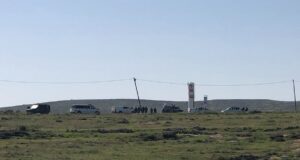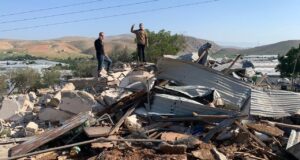5 May 2009
Over one hundred Israeli and Palestinian members of Combatants for Peace gathered peacefully in the Palestinian village of Susiya on 5 May to mark the installation in the village of solar panels and a wind turbine which will provide electricity to the Palestinian village in the South Hebron Hills.
After viewing the panels and turbine, and listening to leaders of the nonviolent resistance in the South Hebron Hills, the group walked towards a house that settlers from the nearby Susiya settlement had built on Palestinian land. Soldiers met the group and read aloud an order declaring the area closed. The group then returned to the village and remained for two hours, talking together and learning about the effects of the occupation on the area.
The original village of Susiya was established in the 1830’s when Palestinians from the South Hebron region purchased the land on the outskirts of the region. Israeli settlers established the settlement of Susiya in l983, and in l986 the Israeli military evicted the villagers from their original cave homes. Some of the families returned to their land but lived in homes scattered over several hilltops.
In the l990’s the military established a military base about 2 km away, and under this military protection Israeli settlers were able to expand onto more of the land that originally belonged to the village of Susiya. Settlers became increasingly violent, and stopped Palestinian farmers form cultivating their land; regularly attacking them. During the l990’s three Palestinians were murdered. In 2001, after the murder of a settler, the entire village was again forcibly evicted by the Israeli army, which used heavy machinery to destroy the cave homes. Over one thousand olive trees were destroyed, and wells were blocked up with sand and rocks. Fields
were destroyed, and livestock were buried alive in pens. Residents were again forcibly removed, but again many returned to their land. Since that time the village has waged a legal battle in the Israeli courts for the right to exist.
 International Solidarity Movement Nonviolence. Justice. Freedom.
International Solidarity Movement Nonviolence. Justice. Freedom.


